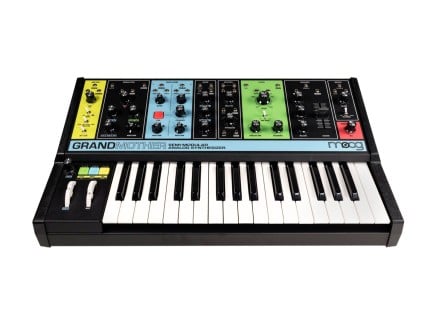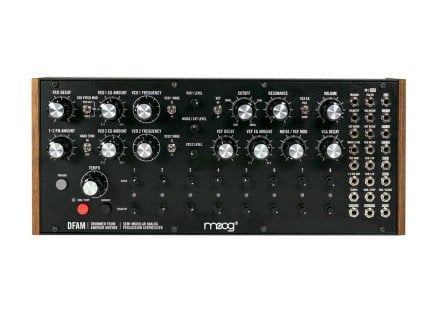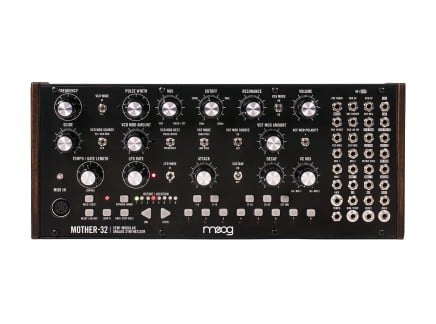We were lucky to get our hands on Moog's new semi-modular instrument, the Subharmonicon, a bizarre instrument based on the subharmonic series. Perfect for polyrhythmic exploration, Just harmonies, and unpredictably animated sonic landscapes, the Subharmonicon is perhaps Moog's strangest instrument in a long time. With the same desktop/Eurorack form factor as the Mother-32 and DFAM, the Subharmonicon works just as well as a desktop instrument as it does an expansion of your Eurorack system.
Subharmonicon can create chords, complex rhythms, huge six-oscillator bass sounds, and more—however, some concepts in the Subharmonicon are a bit complex and might require some re-thinking of how you approach harmony and rhythm. While diving into its weird internal logic might be strange at times, it often leads you to completely new places...breaking you out of your sonic habits and revealing a rich world of kaleidoscopic rhythms and shifting harmony.
If you're just getting to know the Subharmonicon, check out the video above—our hosts Trevor and Trovarsi talk through all of its functionality, and discuss some ways that you can approaching thinking about harmony and rhythm in this bizarre and fascinating instrument.
What is Subharmonicon?
Subharmonicon is based on some bizarre musical concepts: it relies on creating harmonies and rhythms based on the subharmonic series. We cover this concept a bit more deeply in our Subharmonicon announcement article, so read there for deeper detail—but suffice to say, this isn't your standard way of creating harmony or rhythmic structures. Subharmonicon has two oscillators, each of which have two tunable sub oscillators. These sub oscillators don't allow for continuous tuning, however—they are locked to subdivisions of their respective oscillator's frequencies. By locking to integer subdivisions of the main oscillators' frequencies (subdivisions from /1 to /16, specifically), they allow the creation of bizarre microtonal scales and harmonies. The subharmonic series from /16 to /1 passes through stages of seeming somewhat like a major scale and somewhat like a minor scale...making for a novel, rich-sounding set of melodic and harmonic opportunities.
And of course, by offering two independent oscillators each with two tunable sub oscillators, this means you can create up to six-part harmonies. By tuning the two main oscillators to the same frequency or complementary frequencies, you can create rich interactions between all of the sub oscillators—sometimes harmonious, sometimes quite dissonant and clangorous. With careful listening, you'll unearth a world of beat frequencies, binaural fluctuations, and more. And since each of the sub oscillators' division amounts are voltage-controllable, you can create sweeping subharmonic arpeggios that interact with one another to form spiraling sequences of harmony and dissonance.
The two four-step sequencers work based on a similar principle. The sequencers are driven by a master tempo control and four "rhythm generators." These rhythm generators are each clock dividers fed by the same master clock, each tunable from /1 to /16 division amounts (sound familiar?). You can select which of these rhythm generators are used to drive each sequencer, and since multiple selections are allowed, it is easy to make each of the sequencers advance with an unpredictable swing/swagger. Resulting in rhythms based on the subharmonic series, this imposes structures similar to the chords formed by the sub oscillators...offering a unifying principle of rhythm and harmony equally strange and rewarding in each domain. The sequencers can control the oscillators' pitches and/or the sub oscillators' tuning amounts, making for rich ways of animating your sound.
Of course, there's much more to it than that—it offers an integrated quantizer for easy switching between continuous, equal-tempered, and just intonation-derived pitch intervals. It also includes a 24dB/oct Moog filter, as well as filter and amplitude envelopes for sculpting a wide range of articulations. A fully-featured CV/gate patch bay and MIDI input mean that you can control the Subharmonicon in a wide variety of ways, and can further experiment with making different parts of its internal structure interact with one another.
The Subharmonicon is certainly a strange synth, and one that you may not see an obvious place for in your setup. But once you start diving in and deeply listening to its bizarre, ear-bending internal rhythms and harmonies, you'll find that it is a rich world all its own—one from which entirely new musical structures will emerge and disperse through the rest of your studio.











